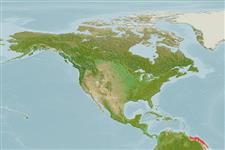Common names from other countries
Environment: milieu / climate zone / depth range / distribution range
экология
; пределы глубины 100 - 298 m (Ref. 271). Tropical; 14°N - 1°N, 58°W - 47°W (Ref. 4)
Western Atlantic.
Length at first maturity / Size / Вес / Возраст
Maturity: Lm ? range ? - ? cm Max length : 10.0 cm TL самец/пол неопределен; (Ref. 271)
It has lengths of 10 cm, maximum body length; 1.6 to 3.2 cm, carapace length (Ref. 4). Occurs at depths from 120 and 298 m, but there is a record from the littoral zone, and one from 4111 to 4122 m. The bottom is variously described as "sand and coral, "sandy calcarenite", and "smooth, consisting of brown mud" (Ref. 4).
Life cycle and mating behavior
половая зрелость | размножение | нерест | икра | Fecundity | личинки
Members of the order Decapoda are mostly gonochoric. Mating behavior: Precopulatory courtship ritual is common (through olfactory and tactile cues); usually indirect sperm transfer.
Основная ссылка
ссылки | координатор | соавторы
Holthuis, L.B. 1991. (Ref. 4)
Статус Красного Списка МСОП (Ref. 130435)
Статус СИТЕС (Ref. 108899)
Not Evaluated
Not Evaluated
Использование человеком
рыболовство: интереса не представляет
| FishSource |
инструменты
дополнительная информация
Возраст/Размеры
рост
Зависимость между длиной и массой тела
Зависимость между длинами
морфология
личинки
численность
ресурсы в Интернет
Estimates based on models
Preferred temperature
(Ref.
115969): 13.6 - 18.8, mean 17.6 (based on 5 cells).
Уязвимость
Low vulnerability (10 of 100).
